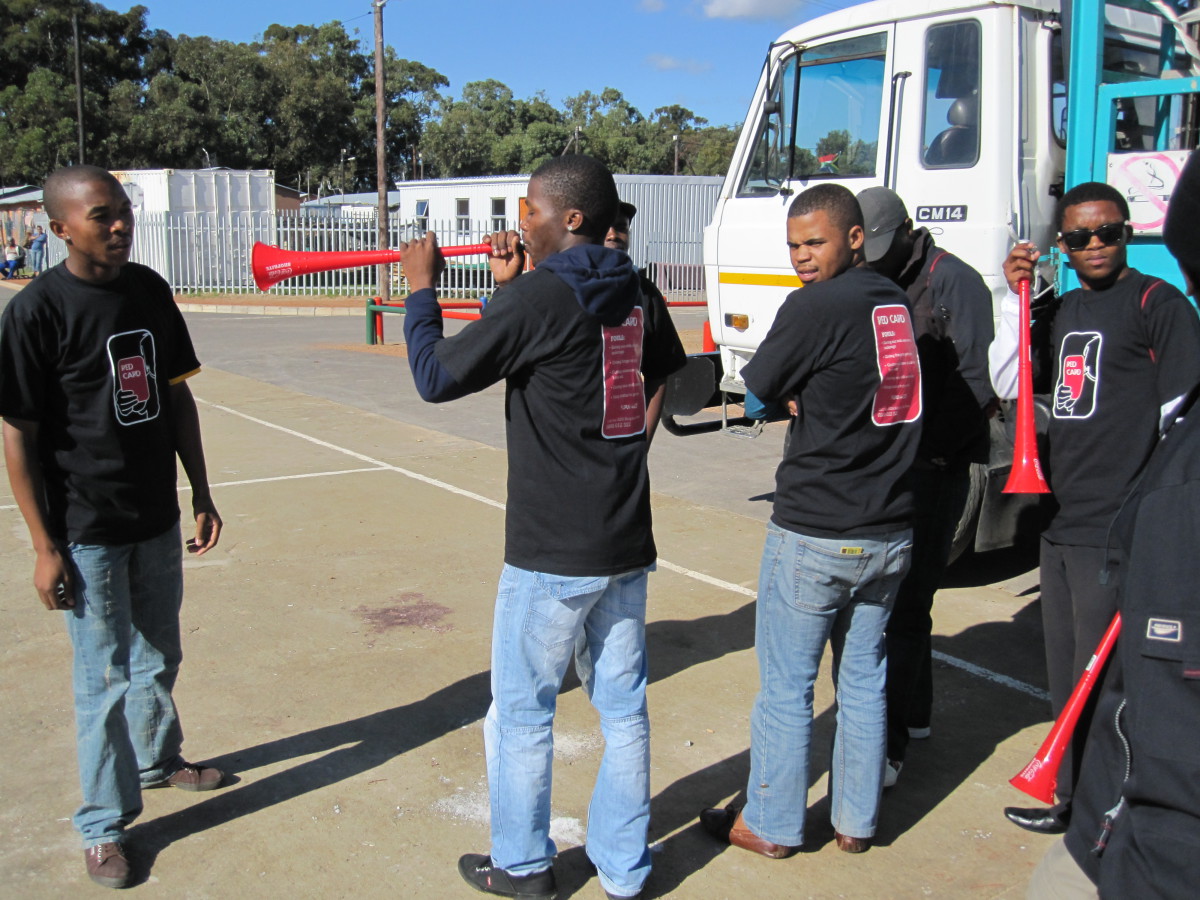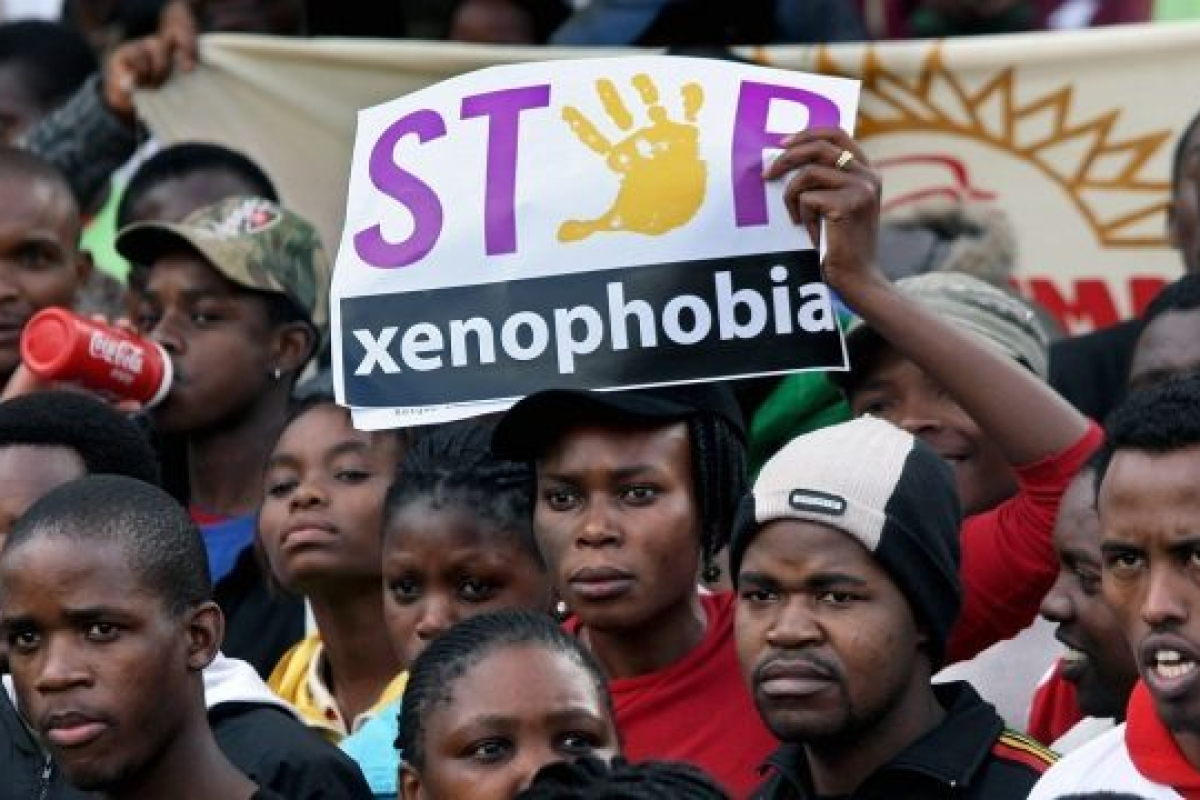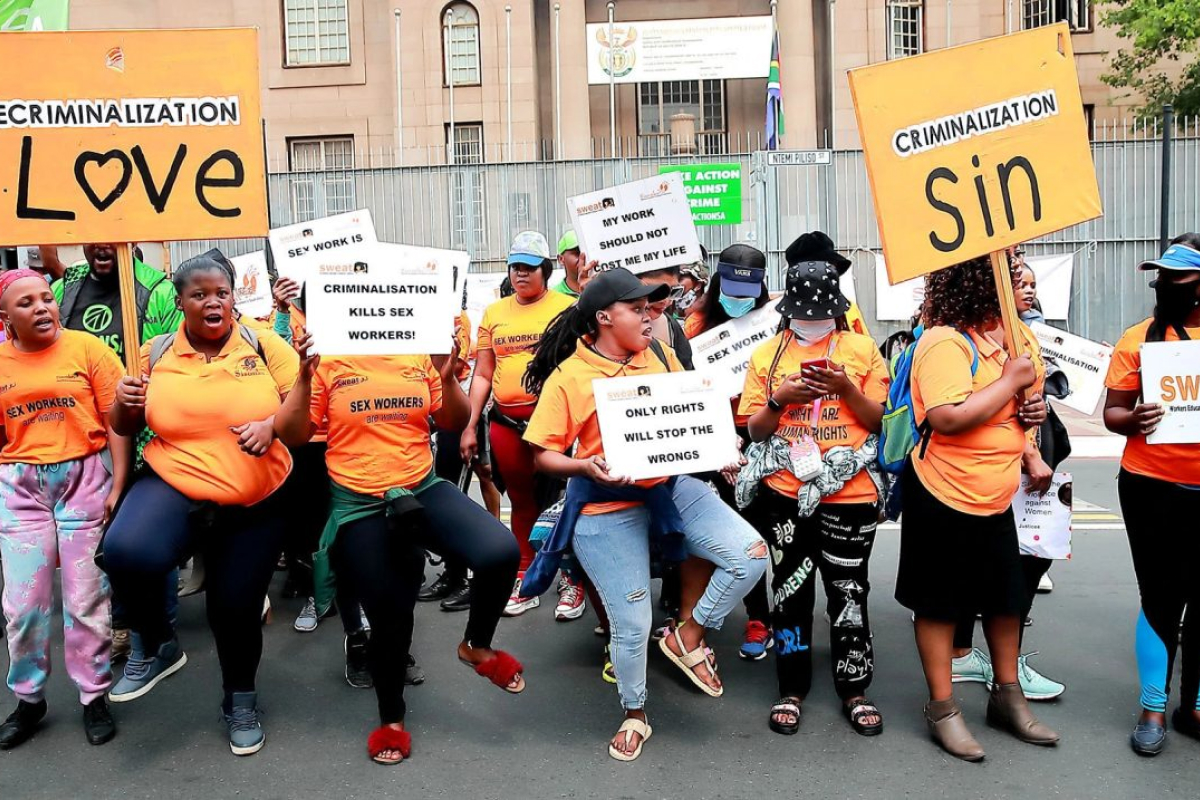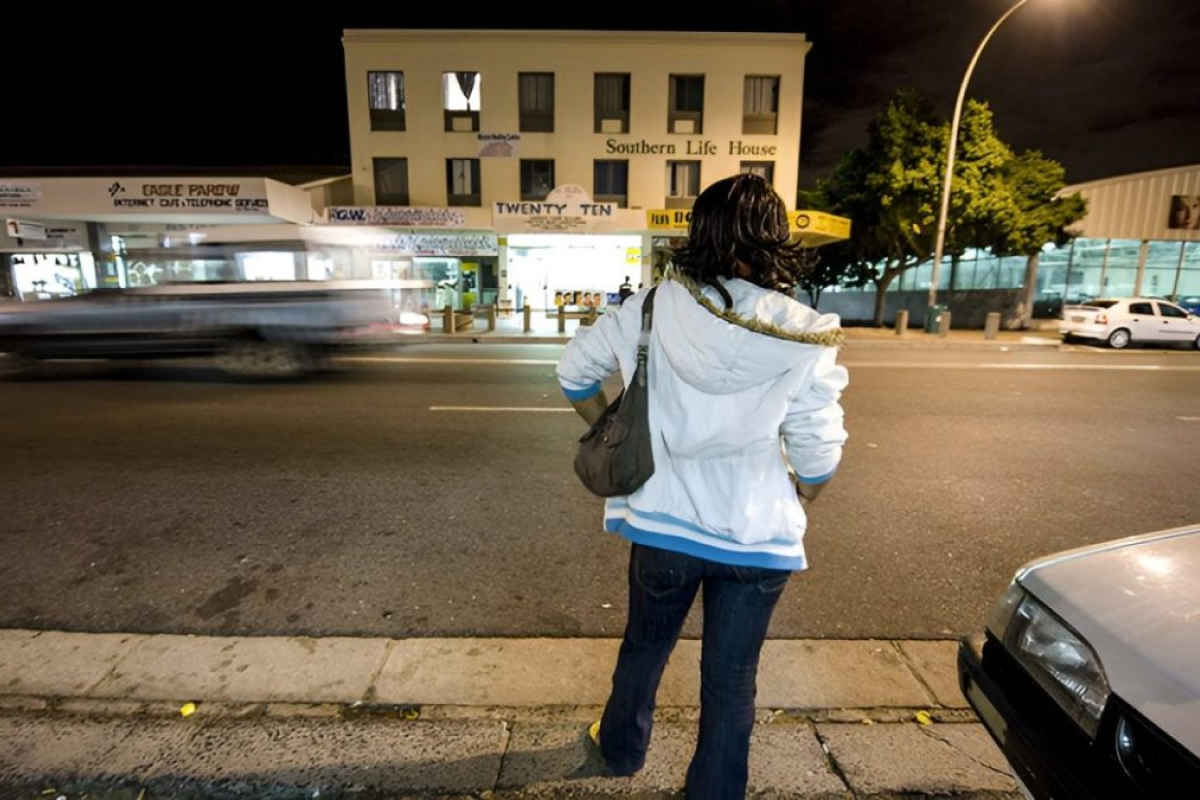Sonke has just finalised an evaluation of the Red Card Campaign which was run between May and Dec 2010. The evaluation highlighted a number of internal and external challenges to the campaign, but generally backed up the campaign approach and materials. Of key importance, was the clear finding that sexual exploitation is a major concern in our communities, and that often exploitative situations or behaviours are accepted to due to lack of knowledge and awareness. The Red Card Campaign is an important tool to use to raise awareness about child sexual exploitation and equip people to take action.
Child Sexual Exploitation
Child sexual exploitation affects millions of girls and boys globally and is a growing problem in Southern Africa. It can include “any actual or attempted abuse of a position of vulnerability, differential power, or trust, for sexual purposes” (UN Secretariat, 2003). While it is difficult to determine the precise nature and extent of child sexual exploitation in South Africa, it is widely acknowledged that it is a growing problem and takes many forms. In South Africa one of the most pervasive forms is transactional sex, where, most often, young girls sleep with older men in exchange for gifts. These gifts can take many forms, including school fees, clothes, jewellery, shoes or even groceries for her family. This occurs most commonly between young girls or women and older men, but it does happen between young men and older women as well.
The Red Card Campaign
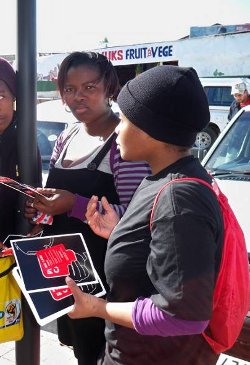
|
The Red Card Campaign used the sports metaphor of a red card to reduce children and especially girls’ vulnerability to sexual exploitation during and after the 2010 FIFA World Cup in South Africa and elsewhere in southern Africa. A partnership between Sonke, Grassroot Soccer and various other NGOs, the campaign focused on increasing awareness regarding sexual exploitation and increasing the ability and willingness of people to intervene to prevent and/or report it. An integrated set of activities were designed and implemented aimed at raising awareness, prevention, and changing attitudes and behaviour, especially among men and boys.
Overall, the campaign made every effort to ensure that participants and viewers understood both the legal and the ethical dimensions of sexual exploitation broadly, but with an emphasis on the particular gravity of sexual exploitation of children.
The campaign activities were focused in Johannesburg and Cape Town, where 22 partner organisations participated in training and roll-out of activities, which included door-to-door campaigns, a Red Card quiz, distribution of information and materials at shopping centres, transport hubs and traffic lights and ambush theatre performances.
Campaign messages were published and broadcast across local and national print, radio and television media, reaching millions of people across the country.
Ranging from Scrutinize television animerts which were broadcast widely on national TV during the world cup, to radio public service announcements, interviews and full-page magazine ads, the media aspect of the campaign, sought to raise general awareness about child sexual exploitation, calling on the public to step in and stop potentially harmful situations.
One of the innovative aspects of the campaign was the strong emphasis on Ambush Theatre. Also called Invisible Theatre, this involves the performance of a thought-provoking scene in a public space, without passers-by being aware that it is theatre. The audience is drawn into the action and invited to participate in a discussion of the issues. Sonke adopted this as a key means of raising awareness about sexual exploitation and demonstrating the Red Card approach. The Red Card toolkit included instructions on how to perform Ambush Theatre and an Ambush Theatre instructional video and real-world demonstration, filmed in Cape Town at the Claremont taxi rank during the campaign activation. This performance clearly indicates how Ambush Theatre can be used to get attention and spark debate and discussions around sexual exploitation of children and the “fouls” that deserve the Red Card.
In both cities, the campaign was well received with red card recipients acknowledging that child sexual exploitation is rampant in their communities and supporting the effort to do something proactive to stop this. It was especially encouraging to see how taxi drivers and taxi rank marshals showed an interest in the initiative and the Red Card “fouls”.
Evaluation Findings
The evaluation of the Red Card Campaign was led by UCT researcher Dr Chris Colvin, with field support from Sonke staff and interns. The evaluation focussed on the reach of the campaign, the initial impact of the workshops on participant attitudes towards and knowledge about child sexual exploitation, and the implementation of the RCC from the perspective of the NGO staff and volunteers.
In terms of scope, the campaign reached a large number of people directly through training and public activities, and had a further media reach of millions of people. In total, 1,163 people completed the Sonke Red Card training which enabled them to roll out the campaign further, and 12,126 learners completed the Grassroot Soccer Red Card module. Although it is too early to determine the impact of the campaign, initial workshop assessments indicated that, especially amongst Grassroot Soccer’s young participants, knowledge of the links between HIV and inter-generational sex improved significantly.
A number of common themes emerged during the interviews. The general feeling was that the campaign was very relevant and needed, and everyone interviewed felt that they had benefitted from being involved. Communities reiterated over and over again that this type of campaign should be ongoing and not be a “once-off” initiative, as the issue of transactional and exploitative sex is so pervasive in many communities.
People commented positively on the importance of the campaign in relation to HIV. Participants spoke of the fatigue associated with HIV awareness and prevention campaigns and then compared these with this topic, highlighting that it is something people do not often speak about. One participant said, “People say they know all about HIV. AIDS on its own is exhausted already, and because the issue of exploitative relationships is actually one of the root causes of HIV spread, it may actually be a more useful topic to discuss”. They emphasized that if this issue can be addressed effectively, then HIV rates would come down. One participant even commented that government should have begun with a campaign such as this one, rather than the Abstain, Be faithful and Condomise campaign.
While numerous people commented on the importance of the campaign and its relevance to our communities, a number of people interviewed also commented on the economic imperatives driving transactional sex. Partners who had conducted red card activities in communities described how many people responded by raising the issue that many children have no choice but to engage in transactional relationships as it is their only way of surviving. One youngster in Johannesburg told the evaluation team that even her parents know that she is dating an older married man and that the parents are also benefitting. She said, “… I buy groceries and bring them home and so who are you to tell me I shouldn’t do this”. One of the parents asked, “I’m unemployed, my husband is unemployed. You’re telling me about this thing but are you going to provide food for this child? Because she is the only one who is providing us with food.”
Some respondents described the extreme jealousy and competition between children at school in terms of material acquisitions. For some young girls, it is not a case of need, but rather of want: “even if you can tell me this, at the end of the day if I ask you to give me R50 to do my hair, you won’t. And even if I can ask my parents and they won’t either, but this daddy will look after me.” Certain men also reacted by saying that it is a two-way street, “It’s the children who come to us, because they need money for bread, money for their hair, which they aren’t getting from their own parents, they are the ones coming to us, so it’s not only about us, it’s about them.”
This highlights the importance of addressing this problem from multiple angles, focussing both on raising the awareness of adults, especially men and boys, and working with young people to help them understand the risks attached to transactional sex and to identify alternatives. It was emphasized that children need to be made aware that “It may seem easy to get money in this way, but rather choose a more difficult option because through sex HIV will come to you.” While the privileged continue to solicit sexual favours from young girls and boys, these youngsters are at increased risk of contracting HIV.
Sonke’s work focussed on adults, and the research clearly shows that the training and activities provided participants with a useful way to understand and communicate the problems of child sexual exploitation and even, in some circumstances, confront people and name problematic behaviours which they had, up to that point, simply accepted.
Grassroot Soccer, on the other hand, focussed on working with learners with a strong focus on the link between intergenerational sex and increased risk of HIV transmission and it is very encouraging that their post workshop results show a very clear increase in awareness on this point.
The evaluation of this initial phase of the campaign, which in many ways can be regarded as a pilot, clearly showed the need for an ongoing campaign addressing issues of child sexual exploitation. The research supports the underlying campaign premise and design and also highlighted some areas in which the campaign can be improved in the next phase, including greater consistency in implementation, a greater focus on sustainability and a need to deepen the content of the training, particularly in relation to providing more technical information about the laws relating to children and sexual offences, the definition of terms, and the nature of the health risks involved in exploitative relationships. Most importantly, future roll-out of the campaign needs to include more concrete ideas about how to respond to exploitative situations which people confront in their own lives. Participants expressed a clear need to know what resources were available, how to get police and social workers more involved, and how they as individuals and communities might further mobilise on their own to prevent child sexual exploitation.
The development and implementation of the Red Card Campaign marks an exciting chapter in Sonke’s growth and experience. There were many challenges faced during the course of the project and we learnt a great deal. The evaluation of the campaign has provided us with enormously useful information on how to improve the campaign itself, as well as how to fine-tune some of our internal processes. Although there is no funding currently in place to take the campaign to the next level, we are actively seeking funding and look forward to being able to put these lessons into practice and help communities create strong opposition to all forms of sexual exploitation of children and women.
Normal 0 false false false EN-ZA X-NONE X-NONE
Red Card Campaign of Key Relevance
By Tapiwa Manyati
Sonke has just finalised an evaluation of the Red Card Campaign which was run between May and Dec 2010. The evaluation highlighted a number of internal and external challenges to the campaign, but generally backed up the campaign approach and materials. Of key importance, was the clear finding that sexual exploitation is a major concern in our communities, and that often exploitative situations or behaviours are accepted to due to lack of knowledge and awareness. The Red Card Campaign is an important tool to use to raise awareness about child sexual exploitation and equip people to take action.
Child Sexual Exploitation
Child sexual exploitation affects millions of girls and boys globally and is a growing problem in Southern Africa. It can include “any actual or attempted abuse of a position of vulnerability, differential power, or trust, for sexual purposes” (2000UN Secretariat, 2003).[1] While it is difficult to determine the precise nature and extent of child sexual exploitation in South Africa, it is widely acknowledged that it is a growing problem and takes many forms. In South Africa one of the most pervasive forms is transactional sex, where, most often, young girls sleep with older men in exchange for gifts. These gifts can take many forms, including school fees, clothes, jewellery, shoes or even groceries for her family. This occurs most commonly between young girls or women and older men, but it does happen between young men and older women as well.
The Red Card Campaign
The Red Card Campaign used the sports metaphor of a red card to reduce children and especially girls’ vulnerability to sexual exploitation during and after the 2010 FIFA World Cup in South Africa and elsewhere in southern Africa. A partnership between Sonke, Grassroot Soccer and various other NGOs, the campaign focused on increasing awareness regarding sexual exploitation and increasing the ability and willingness of people to intervene to prevent and/or report it. An integrated set of activities were designed and implemented aimed at raising awareness, prevention, and changing attitudes and behaviour, especially among men and boys. Overall, the campaign made every effort to ensure that participants and viewers understood both the legal and the ethical dimensions of sexual exploitation broadly, but with an emphasis on the particular gravity of sexual exploitation of children.
The campaign activities were focused in Johannesburg and Cape Town, where 22 partner organisations participated in training and roll-out of activities, which included door-to-door campaigns, a Red Card quiz, distribution of information and materials at shopping centres, transport hubs and traffic lights and ambush theatre performances.
Campaign messages were published and broadcast across local and national print, radio and television media, reaching millions of people across the country. Ranging from Scrutinize television animerts which were broadcast widely on national TV during the world cup, to radio public service announcements, interviews and full-page magazine ads, the media aspect of the campaign, sought to raise general awareness about child sexual exploitation, calling on the public to step in and stop potentially harmful situations.
One of the innovative aspects of the campaign was the strong emphasis on Ambush Theatre. Also called Invisible Theatre, this involves the performance of a thought-provoking scene in a public space, without passers-by being aware that it is theatre. The audience is drawn into the action and invited to participate in a discussion of the issues. Sonke adopted this as a key means of raising awareness about sexual exploitation and demonstrating the Red Card approach. The Red Card toolkit included instructions on how to perform Ambush Theatre and an Ambush Theatre instructional video and real-world demonstration, filmed in Cape Town at the Claremont taxi rank during the campaign activation (2000link). This performance clearly indicates how Ambush Theatre can be used to get attention and spark debate and discussions around sexual exploitation of children and the “fouls” that deserve the Red Card.
In both cities, the campaign was well received with red card recipients acknowledging that child sexual exploitation is rampant in their communities and supporting the effort to do something proactive to stop this. It was especially encouraging to see how taxi drivers and taxi rank marshals showed an interest in the initiative and the Red Card “fouls”.
Evaluation Findings
The evaluation of the Red Card Campaign was led by UCT researcher Chris Colvin, with field support from Sonke staff and interns. The evaluation focussed on the reach of the campaign, the initial impact of the workshops on participant attitudes towards and knowledge about child sexual exploitation, and the implementation of the RCC from the perspective of the NGO staff and volunteers.
In terms of scope, the campaign reached a large number of people directly through training and public activities, and had a further media reach of millions of people. In total, 1,163 people completed the Sonke Red Card training which enabled them to roll out the campaign further, and 12,126 learners completed the Grassroot Soccer Red Card module. Although it is too early to determine the impact of the campaign, initial workshop assessments indicated that, especially amongst Grassroot Soccer’s young participants, knowledge of the links between HIV and inter-generational sex improved significantly.
A number of common themes emerged during the interviews. The general feeling was that the campaign was very relevant and needed, and everyone interviewed felt that they had benefitted from being involved. Communities reiterated over and over again that this type of campaign should be ongoing and not be a “once-off” initiative, as the issue of transactional and exploitative sex is so pervasive in many communities.
People commented positively on the importance of the campaign in relation to HIV. Participants spoke of the fatigue associated with HIV awareness and prevention campaigns and then compared these with this topic, highlighting that it is something people do not often speak about. One participant said, “People say they know all about HIV. AIDS on its own is exhausted already, and because the issue of exploitative relationships is actually one of the root causes of HIV spread, it may actually be a more useful topic to discuss”. They emphasized that if this issue can be addressed effectively, then HIV rates would come down. One participant even commented that government should have begun with a campaign such as this one, rather than the Abstain, Be faithful and Condomise campaign.
While numerous people commented on the importance of the campaign and its relevance to our communities, a number of people interviewed also commented on the economic imperatives driving transactional sex. Partners who had conducted red card activities in communities described how many people responded by raising the issue that many children have no choice but to engage in transactional relationships as it is their only way of surviving.One youngster in Johannesburg told the evaluation team that even her parents know that she is dating an older married man and that the parents are also benefitting. She said, “… I buy groceries and bring them home and so who are you to tell me I shouldn’t do this”. One of the parents asked, “I’m unemployed, my husband is unemployed. You’re telling me about this thing but are you going to provide food for this child? Because she is the only one who is providing us with food.”
Some respondents described the extreme jealousy and competition between children at school in terms of material acquisitions. For some young girls, it is not a case of need, but rather of want: “even if you can tell me this, at the end of the day if I ask you to give me R50 to do my hair, you won’t. And even if I can ask my parents and they won’t either, but this daddy will look after me.” Certain men also reacted by saying that it is a two-way street, “It’s the children who come to us, because they need money for bread, money for their hair, which they aren’t getting from their own parents, they are the ones coming to us, so it’s not only about us, it’s about them.”
This highlights the importance of addressing this problem from multiple angles, focussing both on raising the awareness of adults, especially men and boys, and working with young people to help them understand the risks attached to transactional sex and to identify alternatives. It was emphasized that children need to be made aware that “It may seem easy to get money in this way, but rather choose a more difficult option because through sex HIV will come to you.” While the privileged continue to solicit sexual favours from young girls and boys, these youngsters are at increased risk of contracting HIV.
Sonke’s work focussed on adults, and the research clearly shows that the training and activities provided participants with a useful way to understand and communicate the problems of child sexual exploitation and even, in some circumstances, confront people and name problematic behaviours which they had, up to that point, simply accepted.
Grassroot Soccer, on the other hand, focussed on working with learners with a strong focus on the link between intergenerational sex and increased risk of HIV transmission and it is very encouraging that their post workshop results show a very clear increase in awareness on this point.
The evaluation of this initial phase of the campaign, which in many ways can be regarded as a pilot, clearly showed the need for an ongoing campaign addressing issues of child sexual exploitation. The research supports the underlying campaign premise and design and also highlighted some areas in which the campaign can be improved in the next phase, including greater consistency in implementation, a greater focus on sustainability and a need to deepen the content of the training, particularly in relation to providing more technical information about the laws relating to children and sexual offences, the definition of terms, and the nature of the health risks involved in exploitative relationships. Most importantly, future roll-out of the campaign needs to include more concrete ideas about how to respond to exploitative situations which people confront in their own lives. Participants expressed a clear need to know what resources were available, how to get police and social workers more involved, and how they as individuals and communities might further mobilise on their own to prevent child sexual exploitation.
The development and implementation of the Red Card Campaign marks an exciting chapter in Sonke’s growth and experience. There were many challenges faced during the course of the project and we learnt a great deal. The evaluation of the campaign has provided us with enormously useful information on how to improve the campaign itself, as well as how to fine-tune some of our internal processes. Although there is no funding currently in place to take the campaign to the next level, we are actively seeking funding and look forward to being able to put these lessons into practice and help communities create strong opposition to all forms of sexual exploitation of children and women.

